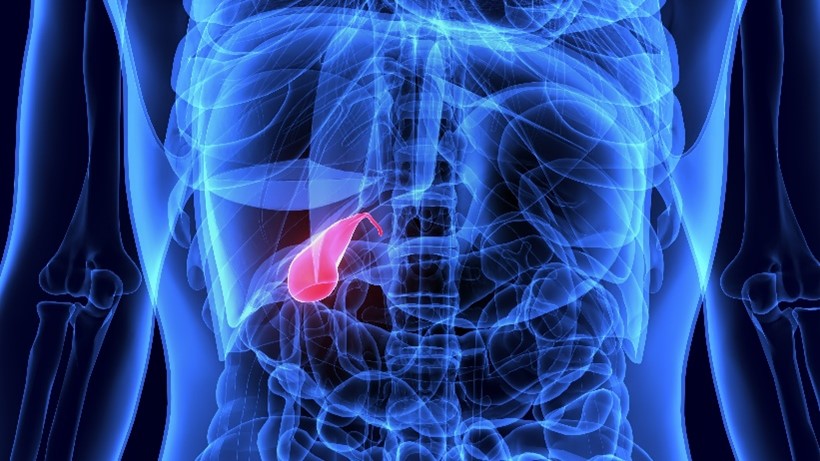Everything You Need to Know About Gallstones
Gallstones are lumps formed by hardened deposits of bile waste in your gallbladder. Your gallbladder is an organ that sits directly below your liver. Your liver releases bile and it is stored in the gallbladder. Your gallbladder is roughly the size of a pear when full of bile, and flat like a balloon after releasing bile. When you eat, hormones trigger your gallbladder to release bile into the small intestine to aid in digesting fat. Bile also carries wastes that your body makes when it breaks down red blood cells, cholesterol, and bilirubin. It is the waste that can harden and form gallstones. There are two types of gallstones. The most common, about 80% of gallstones, are cholesterol stones which are yellow-green. The other type are pigment stones, which are smaller and darker and made up of bilirubin. The medical term for gallstones is cholelithiasis.
Gallstones vary in size from as small as a grain of sand to the size of a golf ball. Many people have gallstones without any problems. Since the gallbladder squeezes the bile through several tubes called ducts, it is when gallstones become large enough or numerous enough to block a duct that a problem occurs causing an inflamed gall bladder, cholecystitis.
Symptoms of Gallstones:
- pain on the right-hand side of the body, just below the ribs
- back pain between the shoulder blades
- pain in the right shoulder
- nausea
- digestive problems – indigestion, heartburn, gas
- vomiting
- sweating
- restlessness
Serious symptoms requiring immediate medical care
- belly pain lasting several hours
- fever and chills
- yellow skin or eyes
- dark urine or light-colored feces

Causes
Gallstones are caused by a chemical imbalance in the gallbladder, causing excess cholesterol, calcium bilirubinate, or calcium carbonate. Cholesterol gallstones are the most common and caused by excess cholesterol in the bile. Pigment gallstones are much rarer and are caused by excess bilirubin in the bile. These are more common in someone with liver disease, blood disorders, or infected bile ducts. A malfunctioning gallbladder that does not empty completely can also cause a concentration of the chemicals that create stones.
Risk Factors for Developing Gallstones
- Family History
- Female
- Over age 40
- Native American or Mexican descent
- Obesity
- Diet – high fat and cholesterol, low fiber
- Lack of exercise
- Medications – lower cholesterol, hormone replacement therapy, birth control
- Pregnant
- Diabetic
- Chron’s Disease or other intestinal disease
- Cirrhosis of the liver
- Hemolytic anemia
- Weight loss – excessive and quick
- Fasting
Experts do not know why a chemical imbalance occurs in some people to cause the gallstones. They do know that gallstones are much more common in people with obesity, especially women. One study showed that women with bulging midriffs double their chances for developing gallstones that create problems requiring surgery. Approximately 20 million people have gallstones.
Diagnosing Gallstones
Interestingly, gallstones are frequently discovered when someone is being treated for a completely different medical issue. Sometimes they are discovered when someone is undergoing cholesterol testing, an ultrasound scan, blood tests, or even x-rays. Once your doctor has completed a physical exam, other tests may be ordered.
- Blood Tests – can show signs of blockage or infection and rule out other potential conditions
- Ultrasound or CT Scan – can provide a picture of the gallbladder and potential stones
- Magnetic Resonance Cholangiopancreatography (MRCP) – a magnetic field and radio waves create pictures of the liver and gallbladder
- Cholescintigraphy (HIDA scan) – tests the functioning of the gall bladder to ensure it is contracting completely, using a harmless radioactive chemical that allows the technician to watch the movements
- Endoscopic Retrograde Cholangiopancreatography (ERCP) – Using an endoscope down your throat a dye is injected so that your bile ducts are visible on x-rays; they can also remove any gallstones in the ducts this way. If the dye does not travel to the liver, bile ducts, intestines, or gallbladder, then a gallstone is likely blocking it.
Treatment
Gallstones do not need to be treated if they are not causing any symptoms, such as inflammation, blockage of the bile ducts, or if they have moved into the intestines. Some small gallstones will naturally pass through the body on their own. Most people with gallstones will require their gallbladder to be removed. The bile from the gallbladder does help to digest fats, but the gallbladder is not essential, and removing it causes no problems with health or digestion, other than a small risk of diarrhea from fat malabsorption. There are two surgical options for removing the gallbladder.
Laparoscopic cholecystectomy – A laparoscope (a narrow tube with a light, camera, and instruments) is inserted through one small cut, the gallbladder is removed through another small cut. This is often referred to as a keyhole surgery and is the most common surgery for gallstones. This can be done as an outpatient surgery.
Open cholecystectomy – Larger incisions are made to remove the gallbladder. Hospitalization is required for a few days and recovery time is several weeks. Approximately 10% of people need open surgery due to a severely inflamed gallbladder or other health reasons.
Medications can be used to dissolve cholesterol stones if you are not a good candidate for surgery due to other health concerns. The medication may take years to totally dissolve the stones, and they may come back if medication is stopped. Diarrhea is a potential side effect of the medications.
Lithotripsy – ultrasonic shock waves break up the gallstones to become small enough to pass naturally through the body. This is a rare treatment when there are only a few gallstones present.
A large percentage of people will have gallstones return within a year of treatment. A preventive medication is given, ursosdeoxyxholic acid, the same acid found in bile. This acid will lower the cholesterol content of the bile reducing the risk of new stones forming.
It is common for someone who has had their gallbladder removed to suffer from feelings of bloating and indigestion, especially following a high-fat meal. Some people have more frequent bowel movements.
Diet
Some experts believe a low fat, high fiber diet may help prevent gallstones. Others believe that may cause rapid weight loss which is another risk of gallstones. Healthy eating habits including a balanced diet and regular meal schedule can have a positive impact on controlling weight without rapid weight loss, which will be beneficial in reducing risks. Avoiding foods high in saturated fats can help reduce the risk of gallstones, since excess cholesterol is involved in forming gallstones. Vegetarians also have a significantly lower risk of developing gallstones.
Central Valley Surgical Specialists in Bakersfield, California are very experienced in the treatment of gallstones. If you are experiencing any of the above symptoms, call us today.

Locations
Bakersfield
8307 Brimhall Rd, STE 1706
Bakersfield, CA 93312
Delano
1205 Garces Hwy, STE 303 Delano, CA 93215
Open Hours
Monday - Friday: 8am – 5pm
Holidays: Closed

